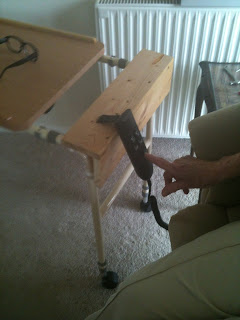On this occasion I did have to buy some timber, but not enough to make it an expensive project. Here is the table (higher than you might expect because it has to be level with the bedside rail FIL uses to move himself about). It was something of a rush job so the finish is just a wipe-on liquid wax.
The strange looking triangular piece in the front corner is where the remote control is now fixed by zip ties at a 45 degree angle to the horizontal (and pointing diagonally at the tv in the corner of the room. It turns out that FIL can both see and operate the buttons (we had wondered whether semi-horizontal pressing would be possible for him, but it is). The lamp sits on the lower section at the back. The lower shelf carries books as ballast.
Meanwhile the design of the Kindle stand has progressed. My first effort arose from FIL's finding it awkward (later impossible) to hold the Kindle on his chest while reading in bed:
Then it became difficult for him to operate the small power button at the base of the Kindle - particularly necessary when you have dozed off in the night and wake to discover that the Kindle has automatically gone to sleep, too. So version 2 incorporated a big spring-loaded button which presses on the tiny switch and which made it possible for a while for the Kindle to be switched back on:
However, these first 2 stands were relatively heavy, being made from offcuts of MDF, and FIL increasingly found it difficult to manipulate them. Additionally, the operation of the big button became problematic. I made a big breakthrough when I discovered a web forum which explained how to use the Kindle's programming language to disable the auto-switch-off routine. No more finding it unusable after a brief doze. So Kindle 3 addressed the weight issue, being made of thin plywood with weight-saving cutouts wherever possible:
This worked well for a while, until FIL found it increasingly difficult to operate the small page-turning buttons at the side of the Kindle. So now we have version 4 - lightweight again but this time providing large pivoting buttons to turn the pages back and forward. This is the one I'm putting my name on!












.JPG)


































.JPG)
.JPG)
